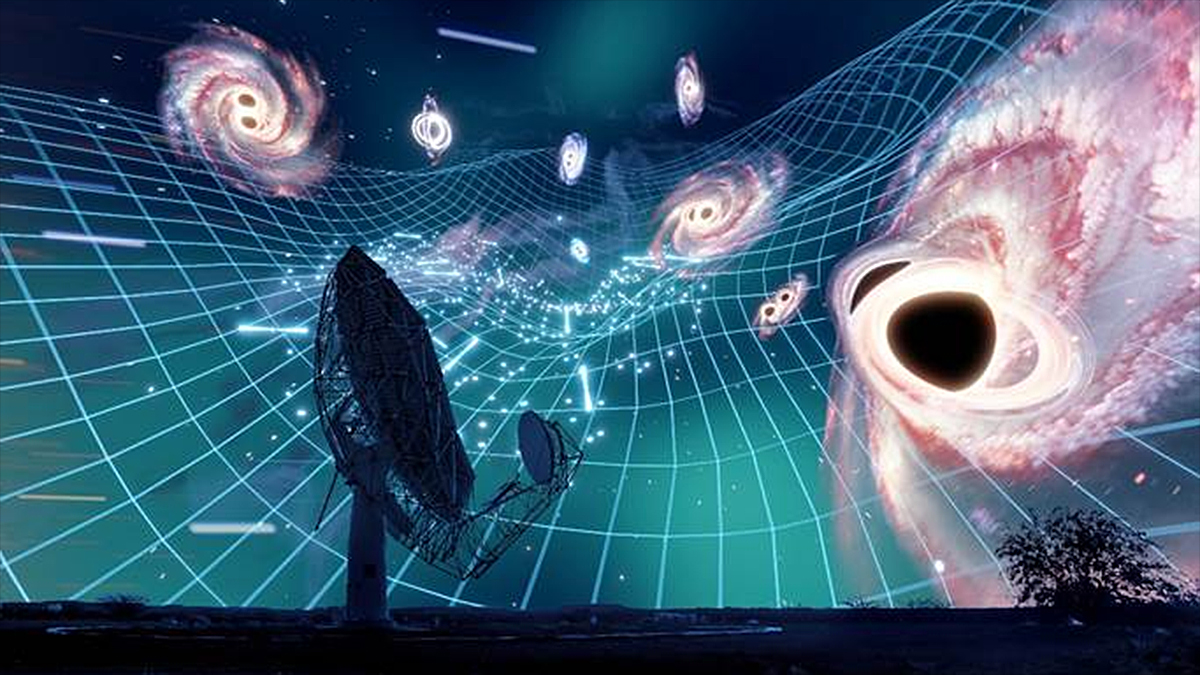
The University of Cape Town (UCT), in collaboration with the South African Radio Astronomy Observatory (SARAO) and international institutions, has made strides in unveiling the mysteries of the universe.
Harnessing the capabilities of South Africa’s MeerKAT radio telescope, the collaboration found evidence for a low-frequency gravitational wave background – cosmic ripples in spacetime that stretch and squeeze the fabric of the universe, says UCT in a statement.
MeerKAT, originally the Karoo Array Telescope, is a radio telescope inaugurated in 2018, consisting of 64 radio dishes that are 13.5m in diameter and spread over an area of 8km in the Northern Cape.
It is the most sensitive telescope of its kind in the world and is a precursor to the Square Kilometre Array (SKA) radio telescope, to be built in SA and Australia.
According to UCT, the MeerKAT Pulsar Timing Array project, a five-year initiative that began in 2019, utilises the precision of pulsars – rapidly-spinning neutron stars – as natural cosmic clocks.
It explains that these celestial bodies, located thousands of light-years away, act as the largest galactic gravitational wave detector of its kind, leading to the most detailed gravitational wave maps created.
“To find evidence for a gravitational wave background, we first need to model the timing behaviour of each of the pulsars in our network very precisely,” explains Dr Marisa Geyer, co-author and lecturer at UCT and former commissioning scientist of MeerKAT.
“Once we know the individual pulsars well, we can start analysing the combined behaviour of the group of pulsars. If we see pulsars in the same direction in the sky lose time in a connected way, we start suspecting that it is not the pulsars that are acting funny, but rather a gravitational wave background that has interfered.”
The findings, published in the Monthly Notices of the Royal Astronomical Society, represent a collaboration among international partners from UCT, Australia, Europe and SARAO, says the university.
It notes the results offer unprecedented insights into the likely sources of these spacetime ripples – primarily the colossal mergers of supermassive black holes.
UCT postdoctoral fellow Dr Jaikhomba Singha remarks: “Pulsar timing array experiments are long-term in nature and searching for a gravitational wave background is a slow process. From past experience, we know that this may need 15 years of data. It is amazing to see that with MeerKAT, evidence for the signal is possible even in a data-span of just 4.5 years.”
Key discoveries
UCT notes the MeerKAT team is seeing signs of a gravitational wave background, in just one-third of the time compared to other global experiments. The background, likely from merging supermassive black holes, is also a stronger signal than other published results.
Matt Miles, researcher at OzGrav and Swinburne University of Technology, and a lead author of the studies, explains: “The signal we’re seeing hints at a more interesting and active universe than we were expecting. We know that supermassive black holes are out there merging, but now we’re starting to ask where and how many?”
The researchers also used the pulsar timing array to construct a precise gravitational wave sky map.
Kathrin Grunthal, a PhD researcher at the Max Planck Institute for Radio Astronomy and one of the lead authors, points out: “By looking for variations in the gravitational waves across the sky, we hunt for the fingerprint of the astrophysical processes behind the signal.”
The researchers improved upon existing methods to identify a bright spot – an intriguing anomaly suggesting a directional bias in the gravitational wave signal, says UCT.
“The presence of a hotspot could suggest a distinct gravitational wave source, such as a pair of black holes billions of times the mass of our sun,” says Rowina Nathan, a researcher at Monash University and another lead author of the studies.
MeerKAT’s state-of-the-art design, developed by SARAO and operated as a National Research Foundation facility, continues to push the boundaries of astronomical research, UCT adds.
SARAO science operations lead Sarah Buchner comments: “We have achieved fantastic pulsar sensitivity and timing precision with MeerKAT. It is deeply moving to see the exquisite results from the pulsar timing array project.”
According to the university, this research lays the foundation for deeper exploration into the evolution of galaxies and the formation of supermassive black holes.
It says the upcoming SKA-Mid telescope, incorporating MeerKAT and currently under construction in the Karoo, promises to expand these discoveries further, positioning SA at the forefront of the next generation of cosmic exploration.
“It is a wonderful time to work in the field of gravitational waves using pulsar timing experiments,” says UCT PhD student Atiqur Rahman.
“While PTA [pulsar timing array] experiments are seeing increasing evidence for a gravitational wave background, the source of this is not fully known. In my project, we are searching for the presence of unconventional polarisation modes of the gravitational wave signals, to understand their origins better.”
Share